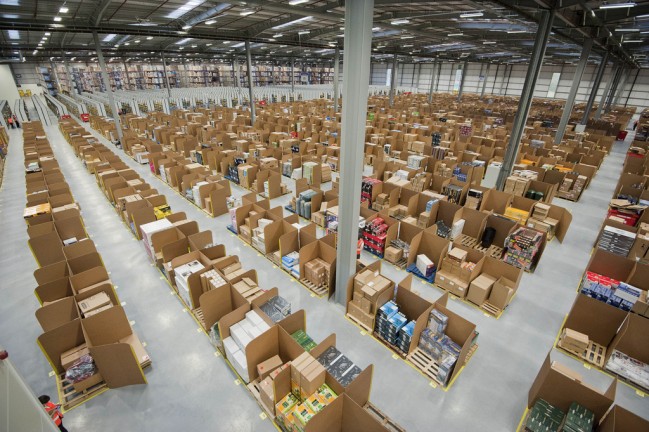When I soak in articles like this one on Amazon’s (the dotcom) vast and ever-growing empire I wonder about the difference between ambition and greed. I used to admire this company tremendously, founded by the singularly focused Jeff Bezos. But, for some reason, when Amazon expanded into retailing groceries my allegiance began to wane. Now that they’re also producing their own entertainment programming, and have their sticky fingers in hundreds of diverse pies, I think I’m starting to dislike and distrust this corporate behemoth. Amazon gave up being a pure retailer a while ago — now they produce original shows and movies; they host e-commerce and manage business services for many other corporations; they run all manner of marketplaces; they compete with distributors. The company does all of this very well.
And, yet.
When did Jeff Bezo’s ambition and that of his 150,000-plus employees — to deliver all manner of stuff so effortlessly and conveniently — morph into what increasingly seems like greed? Because, somewhere along this spectrum of acquisitiveness a noble ambition seems to have become a selfish one.
Oh, and as for the demanding, competitive, brutish workplace — the company seems to be doing nothing more than applying the same principles to its employees as it does from its data-driven retailing and distribution operation. Unfortunately, it seems to have lost sight — as do many companies — that employees remain stubbornly human.
From NYT:
On Monday mornings, fresh recruits line up for an orientation intended to catapult them into Amazon’s singular way of working.
They are told to forget the “poor habits” they learned at previous jobs, one employee recalled. When they “hit the wall” from the unrelenting pace, there is only one solution: “Climb the wall,” others reported. To be the best Amazonians they can be, they should be guided by the leadership principles, 14 rules inscribed on handy laminated cards. When quizzed days later, those with perfect scores earn a virtual award proclaiming, “I’m Peculiar” — the company’s proud phrase for overturning workplace conventions.
At Amazon, workers are encouraged to tear apart one another’s ideas in meetings, toil long and late (emails arrive past midnight, followed by text messages asking why they were not answered), and held to standards that the company boasts are “unreasonably high.” The internal phone directory instructs colleagues on how to send secret feedback to one another’s bosses. Employees say it is frequently used to sabotage others. (The tool offers sample texts, including this: “I felt concerned about his inflexibility and openly complaining about minor tasks.”)
Many of the newcomers filing in on Mondays may not be there in a few years. The company’s winners dream up innovations that they roll out to a quarter-billion customers and accrue small fortunes in soaring stock. Losers leave or are fired in annual cullings of the staff — “purposeful Darwinism,” one former Amazon human resources director said. Some workers who suffered from cancer, miscarriages and other personal crises said they had been evaluated unfairly or edged out rather than given time to recover.
Even as the company tests delivery by drone and ways to restock toilet paper at the push of a bathroom button, it is conducting a little-known experiment in how far it can push white-collar workers, redrawing the boundaries of what is acceptable. The company, founded and still run by Jeff Bezos, rejects many of the popular management bromides that other corporations at least pay lip service to and has instead designed what many workers call an intricate machine propelling them to achieve Mr. Bezos’ ever-expanding ambitions.
“This is a company that strives to do really big, innovative, groundbreaking things, and those things aren’t easy,” said Susan Harker, Amazon’s top recruiter. “When you’re shooting for the moon, the nature of the work is really challenging. For some people it doesn’t work.”
Bo Olson was one of them. He lasted less than two years in a book marketing role and said that his enduring image was watching people weep in the office, a sight other workers described as well. “You walk out of a conference room and you’ll see a grown man covering his face,” he said. “Nearly every person I worked with, I saw cry at their desk.”
Thanks in part to its ability to extract the most from employees, Amazon is stronger than ever. Its swelling campus is transforming a swath of this city, a 10-million-square-foot bet that tens of thousands of new workers will be able to sell everything to everyone everywhere. Last month, it eclipsed Walmart as the most valuable retailer in the country, with a market valuation of $250 billion, and Forbes deemed Mr. Bezos the fifth-wealthiest person on earth.
Tens of millions of Americans know Amazon as customers, but life inside its corporate offices is largely a mystery. Secrecy is required; even low-level employees sign a lengthy confidentiality agreement. The company authorized only a handful of senior managers to talk to reporters for this article, declining requests for interviews with Mr. Bezos and his top leaders.
However, more than 100 current and former Amazonians — members of the leadership team, human resources executives, marketers, retail specialists and engineers who worked on projects from the Kindle to grocery delivery to the recent mobile phone launch — described how they tried to reconcile the sometimes-punishing aspects of their workplace with what many called its thrilling power to create.
In interviews, some said they thrived at Amazon precisely because it pushed them past what they thought were their limits. Many employees are motivated by “thinking big and knowing that we haven’t scratched the surface on what’s out there to invent,” said Elisabeth Rommel, a retail executive who was one of those permitted to speak.
Others who cycled in and out of the company said that what they learned in their brief stints helped their careers take off. And more than a few who fled said they later realized they had become addicted to Amazon’s way of working.
“A lot of people who work there feel this tension: It’s the greatest place I hate to work,” said John Rossman, a former executive there who published a book, “The Amazon Way.”
Amazon may be singular but perhaps not quite as peculiar as it claims. It has just been quicker in responding to changes that the rest of the work world is now experiencing: data that allows individual performance to be measured continuously, come-and-go relationships between employers and employees, and global competition in which empires rise and fall overnight. Amazon is in the vanguard of where technology wants to take the modern office: more nimble and more productive, but harsher and less forgiving.
“Organizations are turning up the dial, pushing their teams to do more for less money, either to keep up with the competition or just stay ahead of the executioner’s blade,” said Clay Parker Jones, a consultant who helps old-line businesses become more responsive to change.
On a recent morning, as Amazon’s new hires waited to begin orientation, few of them seemed to appreciate the experiment in which they had enrolled. Only one, Keith Ketzle, a freckled Texan triathlete with an M.B.A., lit up with recognition, explaining how he left his old, lumbering company for a faster, grittier one.
“Conflict brings about innovation,” he said.
Read the entire article here.


